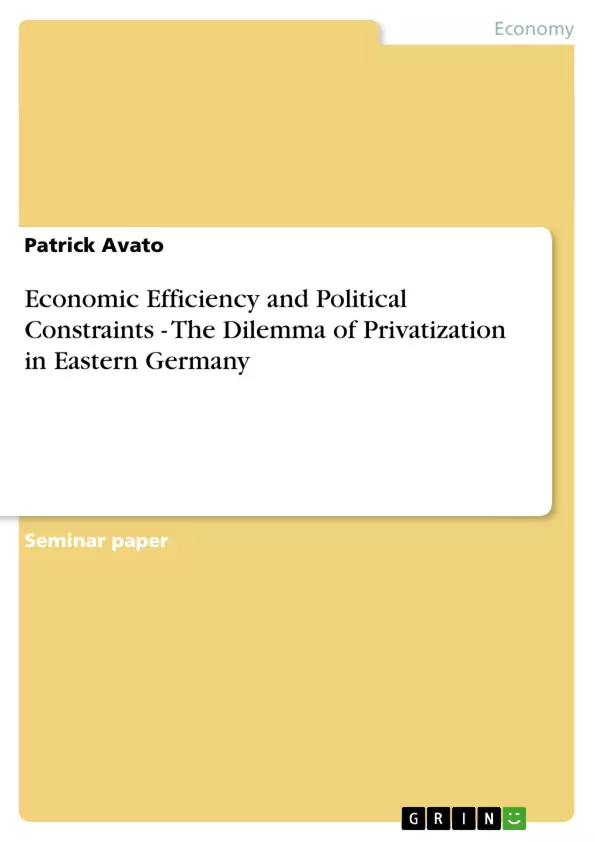Firstly, as typical for a centrally planned socialist economy, the great majority of productive capacity belonged to the state. Large, state owned enterprises (Volkseigene Betriebe), often grouped into huge industrial conglomerates (Kombinate), made up 80.7 percent of total assets. Cooperative property accounted for another 14.7 percent in March 1990. Private property merely amounted to 4.7 percent of economic resources and was confined to small-scale businesses, restaurants, and craft shops. Employment was consequently almost entirely in the hand of the state leaving only about 2 percent of the workforce independently employed (Merkl 1994, p. 200). Also, the structure of the GDR economy differed largely from its western counterpart. Employment was heavily concentrated in sectors and branches that had actually been declining in the West. The production was skewed towards agriculture, energy, mining and manufacturing, which together accounted for 47 percent of employment in the GDR (37 percent in the BRD) (Lange and Pugh 1998, p. 32). As shown in table 1 agriculture, forestry and fishery, energy and mining as well as textiles and clothing employed almost 18 percent of the GDR’s workforce in contrast to 7 percent in West Germany. Further differences appeared in the service and trade sector which, by Western standards, was rather underdeveloped in the GDR. [...]
Inhaltsverzeichnis (Table of Contents)
- Introduction
- German Unification and Economic Transformation
- Privatization
- The Treuhandanstalt
- Phase 1 - Rapid privatization
- Phase 2-Active restructuring
Zielsetzung und Themenschwerpunkte (Objectives and Key Themes)
This paper aims to critically evaluate the process of privatization that accompanied German unification. It delves into the economic challenges of integrating a centrally planned economy into a market economy and analyzes the role of privatization as a means of transformation. The paper specifically focuses on the Treuhandanstalt, the government agency responsible for privatization, and its impact on the East German economy.
- Economic Transformation in Eastern Germany
- Privatization as a Tool for Market Transition
- The Treuhandanstalt and its Role in Privatization
- The Dilemmas of Privatization: Efficiency vs. Equity
- The Impact of Privatization on East German Employment and Economic Performance
Zusammenfassung der Kapitel (Chapter Summaries)
- Introduction: This chapter sets the stage by outlining the economic disparity between Eastern and Western Germany after unification and introduces the debate surrounding privatization. It highlights the increasing dissatisfaction with the post-unification economic landscape and the growing critique of privatization as a policy tool.
- German Unification and Economic Transformation: This chapter explores the economic challenges faced by the GDR following its unification with the BRD. It delves into the structural differences between the two economies, emphasizing the GDR's dependence on state-owned enterprises and its limited exposure to competition. It further discusses the economic shock caused by the adoption of the West German currency and the need for restructuring inefficient enterprises.
- Privatization: This chapter discusses the rationale for privatization as a central component of the transformation process. It highlights the belief that private ownership fosters efficiency and competition, leading to the efficient allocation of resources and increased dynamism in the economy.
- The Treuhandanstalt: This chapter introduces the Treuhandanstalt, the government agency responsible for managing and privatizing the former GDR's state property. It explains the agency's role in converting state enterprises into private companies and its mandate to facilitate economic restructuring. The chapter also highlights the debate surrounding the Treuhand's goals and the potential conflicts between privatization, job security, and economic sustainability.
- Phase 1 - Rapid Privatization: This chapter outlines the first phase of privatization, characterized by a focus on quick sales and the restructuring of state-owned enterprises. It discusses the challenges encountered by the Treuhandanstalt, including property rights issues and the need to classify firms based on their viability. It also emphasizes the Treuhand's efforts to prioritize long-term sustainability and job preservation through the selection of suitable private investors.
- Phase 2 - Active Restructuring: This chapter examines the second phase of privatization, which focused on active restructuring and addressing the continued decline of the East German economy. It addresses the challenges posed by declining GDP, increasing unemployment, and the need to adjust to Western competition. It highlights the political pressures faced by the Treuhandanstalt in balancing economic efficiency with social concerns.
Schlüsselwörter (Keywords)
This paper explores the key concepts of privatization, economic transformation, and the role of state institutions in shaping economic development. It analyzes the interplay between political constraints and economic efficiency in the context of German unification and the integration of a centrally planned economy into a market-based system. The paper focuses on the Treuhandanstalt, a government agency entrusted with privatization, and its impact on the East German economy. It also examines the broader themes of economic restructuring, job creation, and the potential trade-offs between efficiency and equity in the privatization process.
- Quote paper
- Patrick Avato (Author), 2005, Economic Efficiency and Political Constraints - The Dilemma of Privatization in Eastern Germany, Munich, GRIN Verlag, https://www.grin.com/document/39207



